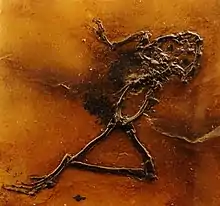| Eopelobates Temporal range: | |
|---|---|
 | |
| Eopelobates wagneri | |
| Scientific classification | |
| Domain: | Eukaryota |
| Kingdom: | Animalia |
| Phylum: | Chordata |
| Class: | Amphibia |
| Order: | Anura |
| Family: | Pelobatidae |
| Genus: | †Eopelobates Parker, 1929 |
| Species | |
| |
| Synonyms | |
| |
Eopelobates is an extinct genus of frogs in the family Pelobatidae.[2] Closely related to the living European spadefoot toad, it is known from the Eocene of western North America, and the Eocene–Pliocene of Europe. It is suggested that the distribution over both Europe and North America is due to dispersal during the Paleocene-Eocene Thermal Maximum.[3]
References
- ↑ "†Eopelobates wagneri Weitzel 1938". Paleobiology Database. Fossilworks. Retrieved 17 December 2021.
- ↑ "†Eopelobates Parker 1929". Paleobiology Database. Fossilworks. Retrieved 17 December 2021.
- ↑ Roček, Zbyněk; Wuttke, Michael; Gardner, James D.; Singh Bhullar, Bhart-Anjan (2014). "The Euro-American genus Eopelobates, and a re-definition of the family Pelobatidae (Amphibia, Anura)". Palaeobiodiversity and Palaeoenvironments. 94 (4): 529–567. doi:10.1007/s12549-014-0169-5. ISSN 1867-1594.
- Spinar, Z.V. & Rocek, Z. 1984. The discovery of the impression of the ventral side of Eopelobates anthracinus Parker, 1929 holotype. Amphibia-Reptilia 5: 87–95.
This article is issued from Wikipedia. The text is licensed under Creative Commons - Attribution - Sharealike. Additional terms may apply for the media files.